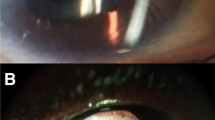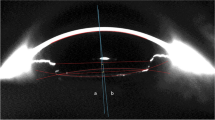Abstract
Background
The performance of a primary posterior capsulorhexis (PPC) with and without posterior optic buttonholing (POBH) may significantly influence the intraocular pressure (IOP) after cataract surgery in age-related cataract patients.
Methods
The prospective randomized clinical study was performed at the department of Ophthalmology, Medical University of Vienna, Austria. Thirty consecutive cataract patients with bilateral same-day cataract surgery (60 eyes) under topical anesthesia were enrolled. In randomized order, cataract surgery with combined PPC/POBH was performed in one eye; in the other eye, cataract surgery was performed with PPC and in-the-bag implantation of the intraocular lens (IOL). Standardized IOP measurements by Goldmann applanation tonometry were performed preoperatively, 1, 2, 4, 6, 8 and 24 hours postoperatively, as well as 1 week and 1 month postoperatively.
Results
During the first 24 hours after surgery, all IOP measurements were significantly lower in eyes with combined PPC/POBH when compared to eyes with solitary PPC (p < 0.001). No IOP peaks of more than 27 mmHg were observed with combined PPC/POBH. In contrast, in eyes with PPC and in-the-bag IOL implantation, seven patients had an IOP peak of more than 27 mmHg and four IOP peaks of more than 30 mmHg. One week and 1 month postoperatively, IOP measurements were statistically comparable, and no significant differences could be observed between the two groups (p > 0.05).
Conclusion
Postoperative IOP peaks after cataract surgery with sole PPC can be effectively prevented by the buttonholing of the IOL through the posterior capsulorhexis.


Similar content being viewed by others
References
Galand A, Cauwenberge F, Moosavi J (1996) Posterior capsulorhexis in adult eyes with intact clear capsules. J Cataract Refract Surg 22:458–461
Gimbel HV (1990) Posterior capsule tears using phaco-emulsification: cause, prevention and management. Eur J Implant Refract Surg 2:63–69
Georgopoulos M, Menapace R, Findl O et al (2003) After-cataract in adults with primary posterior capsulorhexis: comparison of hydrogel and silicone intraocular lenses with round edges after 2 years. J Cataract Refract Surg 29:955–960
Luo Y, Lu Y, Lu G, Wang M (2008) Primary posterior capsulorhexis with anterior vitrectomy in preventing posterior capsule opacification in pediatric cataract microsurgery. Microsurgery 28(2):113–116
Fenton S, O'Keefe M (1999) Primary posterior capsulorhexis without anterior vitrectomy in pediatric cataract surgery: longer-term outcome. J Cataract Refract Surg 25(6):763–767
Menapace R (2007) After-cataract following intraocular lens implantation. Part II: prevention with alternative implants and techniques [Article in German]. Ophthalmologe 104(4):345–353
Tassignon MJ, De Groot V, Vervecken F, Van Tenten Y (1998) Secondary reclosure of posterior continuous curvilinear capsulorhexis in normal eyes and eyes at risk for postoperative inflammation. J Cataract Refract Surg 24:1333–1338
Wirtitsch MG, Menapace R, Georgopoulos M, Rainer G, Buehl W, Heinzl H (2007) Intraocular pressure rise after primary posterior continuous curvilinear capsulorhexis with a fixed dorzolamide-timolol combination: randomized safety study with intraindividual comparison using an angulated and a nonangulated intraocular lens. J Cataract Refract Surg 33(10):1754–1759
Stifter E, Menapace R, Luksch A, Neumayer T, Vock L, Sacu S (2007) Objective assessment of intraocular flare after cataract surgery with combined primary posterior capsulorhexis and posterior optic buttonholing in adults. Br J Ophthalmol 91(11):1481–1484, Epub 2007 May 15
Menapace R (2006) Routine posterior optic buttonholing for eradication of posterior capsule opacification in adults - Report of 500 consecutive cases. J Cataract Refract Surg 32:929–943
Menapace R (2008) Posterior capsulorhexis combined with optic buttonholing: an alternative to standard in-the-bag implantation of sharp-edged intraocular lenses? A critical analysis of 1000 consecutive cases. Graefes Arch Clin Exp Ophthalmol 246(6):787–801, Epub 2008 Apr 19
Stifter E, Menapace R, Kriechbaum K, Vock L, Luksch A (2009) Effect of a primary posterior capsulorhexis with and without posterior optic buttonholing on the postoperative anterior chamber flare. J Cataract Refract Surg 35(3):480–484
Stifter E, Luksch A, Menapace R (2007) Postoperative course of intraocular pressure after cataract surgery with combined primary posterior capsulorhexis and posterior optic buttonholing. J Cataract Refract Surg 33(9):1585–1590
Stifter E, Menapace R, Neumayer T, Luksch A (2008) Macular morphology after cataract surgery with primary posterior capsulorhexis and posterior optic buttonholing. Am J Ophthalmol 146(1):15–22, Epub 2008 Apr 24
Stifter E, Menapace R, Luksch A, Neumayer T, Sacu S (2008) Anterior chamber depth and change in axial intraocular lens position after cataract surgery with primary posterior capsulorhexis and posterior optic buttonholing. J Cataract Refract Surg 34(5):749–754
Author information
Authors and Affiliations
Corresponding author
Additional information
Clinical Trials registration reference number: ISRCTN35593439
None of the authors has a financial or proprietary interest in any material or method mentioned. There are no conflicts of opinion and no organization sponsored the research.
Rights and permissions
About this article
Cite this article
Stifter, E., Menapace, R., Kriechbaum, K. et al. Posterior optic buttonholing prevents intraocular pressure peaks after cataract surgery with primary posterior capsulorhexis. Graefes Arch Clin Exp Ophthalmol 248, 1595–1600 (2010). https://doi.org/10.1007/s00417-010-1454-2
Received:
Revised:
Accepted:
Published:
Issue Date:
DOI: https://doi.org/10.1007/s00417-010-1454-2




